Individual EMBA Macroeconomics Assignment: Economic Risks and Policies
VerifiedAdded on 2022/08/13
|6
|1289
|16
Homework Assignment
AI Summary
This assignment explores the complexities of macroeconomics, beginning with an analysis of the world economic situation and its associated risks. The student identifies and discusses three key international economic risks, based on the provided reading, that could significantly impact a business or organization over a three-year period. The assignment then shifts focus to South Africa's fiscal constraints, recommending a combination of short-term actions to overcome these challenges. The recommended actions include increasing corporate taxes, borrowing internationally, and privatizing state-owned enterprises. The student explains how these measures could affect their business or organization, drawing upon relevant literature and economic principles. The solution provides a comprehensive examination of macroeconomic concepts and their practical implications.
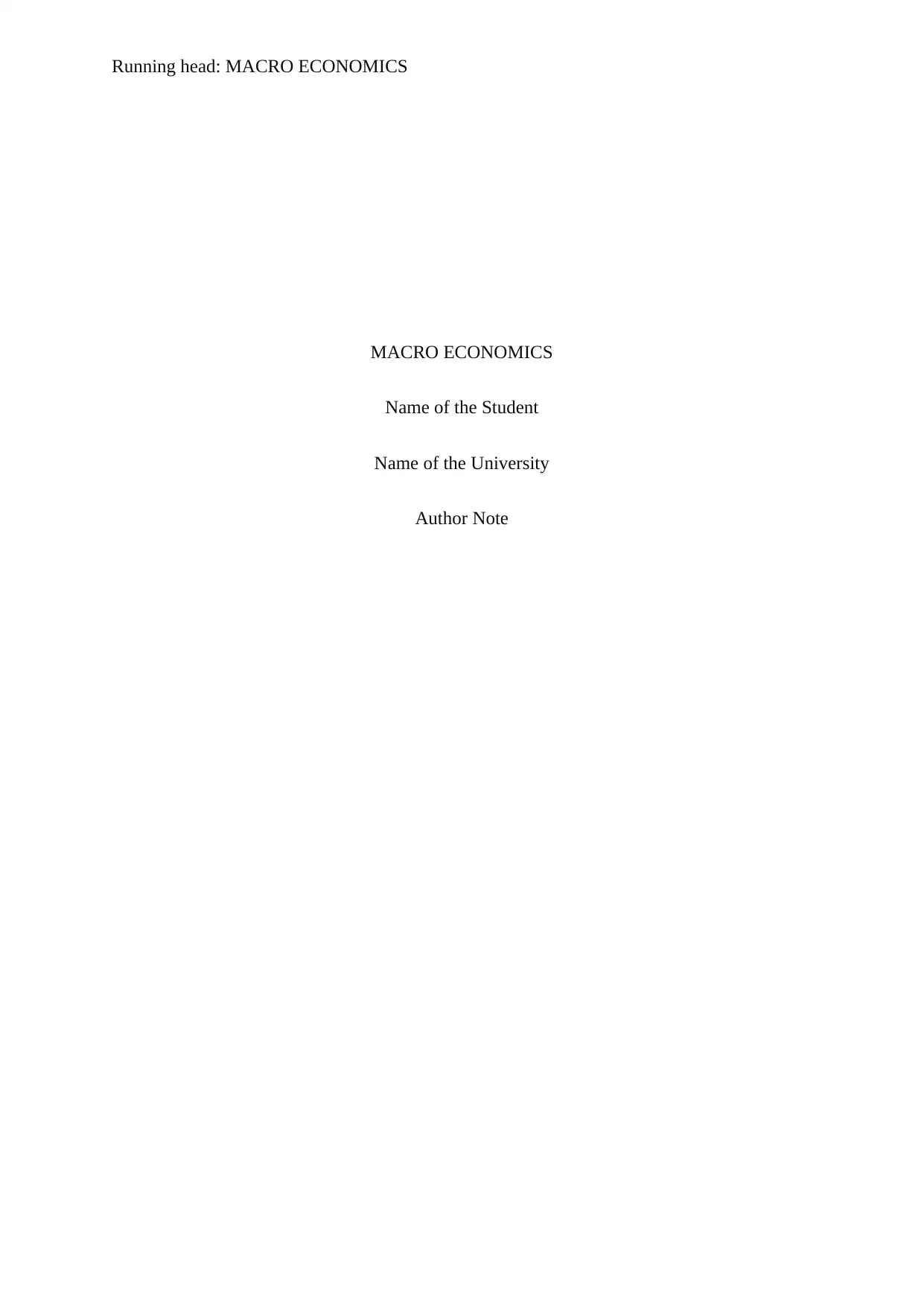
Running head: MACRO ECONOMICS
MACRO ECONOMICS
Name of the Student
Name of the University
Author Note
MACRO ECONOMICS
Name of the Student
Name of the University
Author Note
Paraphrase This Document
Need a fresh take? Get an instant paraphrase of this document with our AI Paraphraser
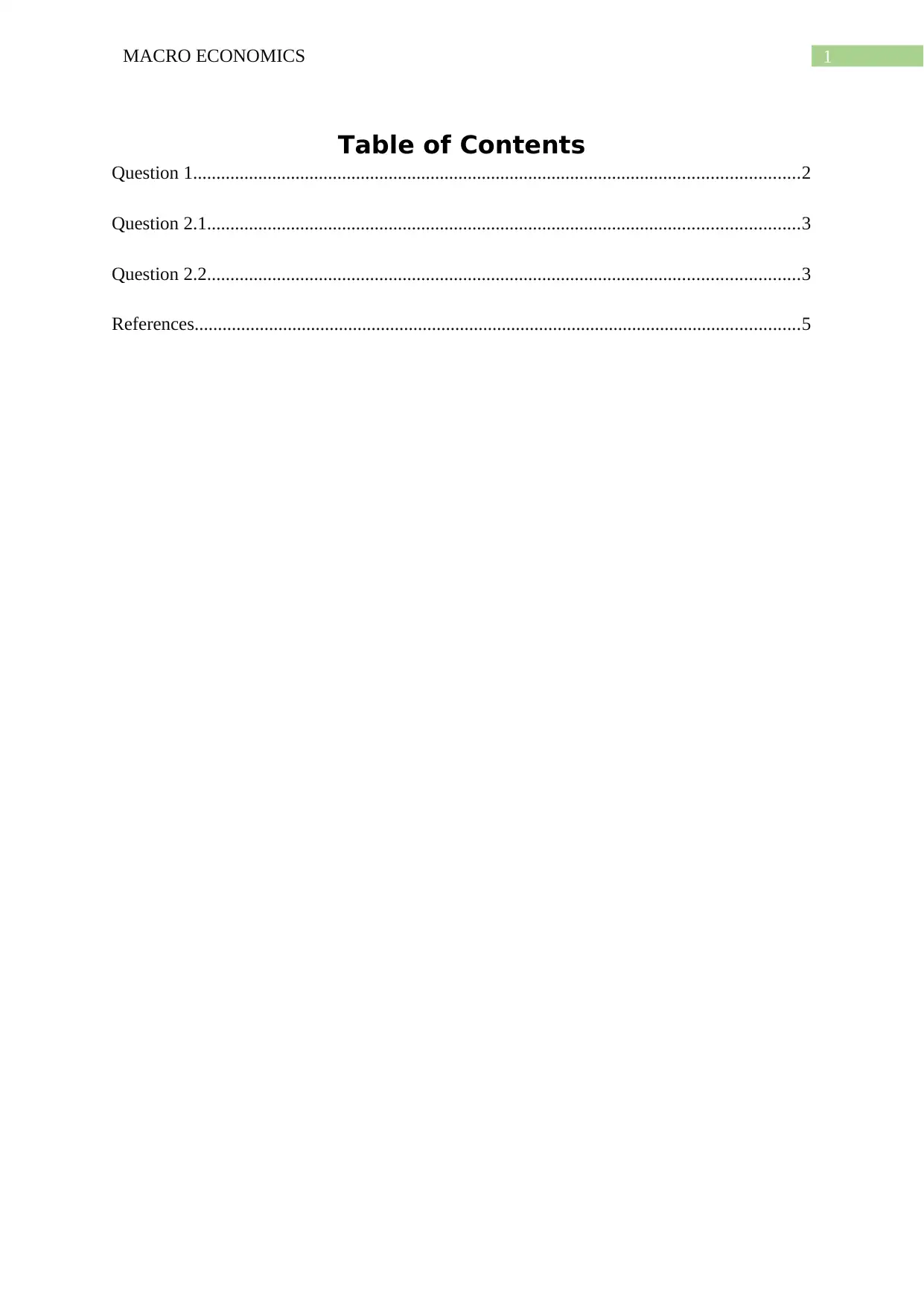
1MACRO ECONOMICS
Table of Contents
Question 1..................................................................................................................................2
Question 2.1...............................................................................................................................3
Question 2.2...............................................................................................................................3
References..................................................................................................................................5
Table of Contents
Question 1..................................................................................................................................2
Question 2.1...............................................................................................................................3
Question 2.2...............................................................................................................................3
References..................................................................................................................................5
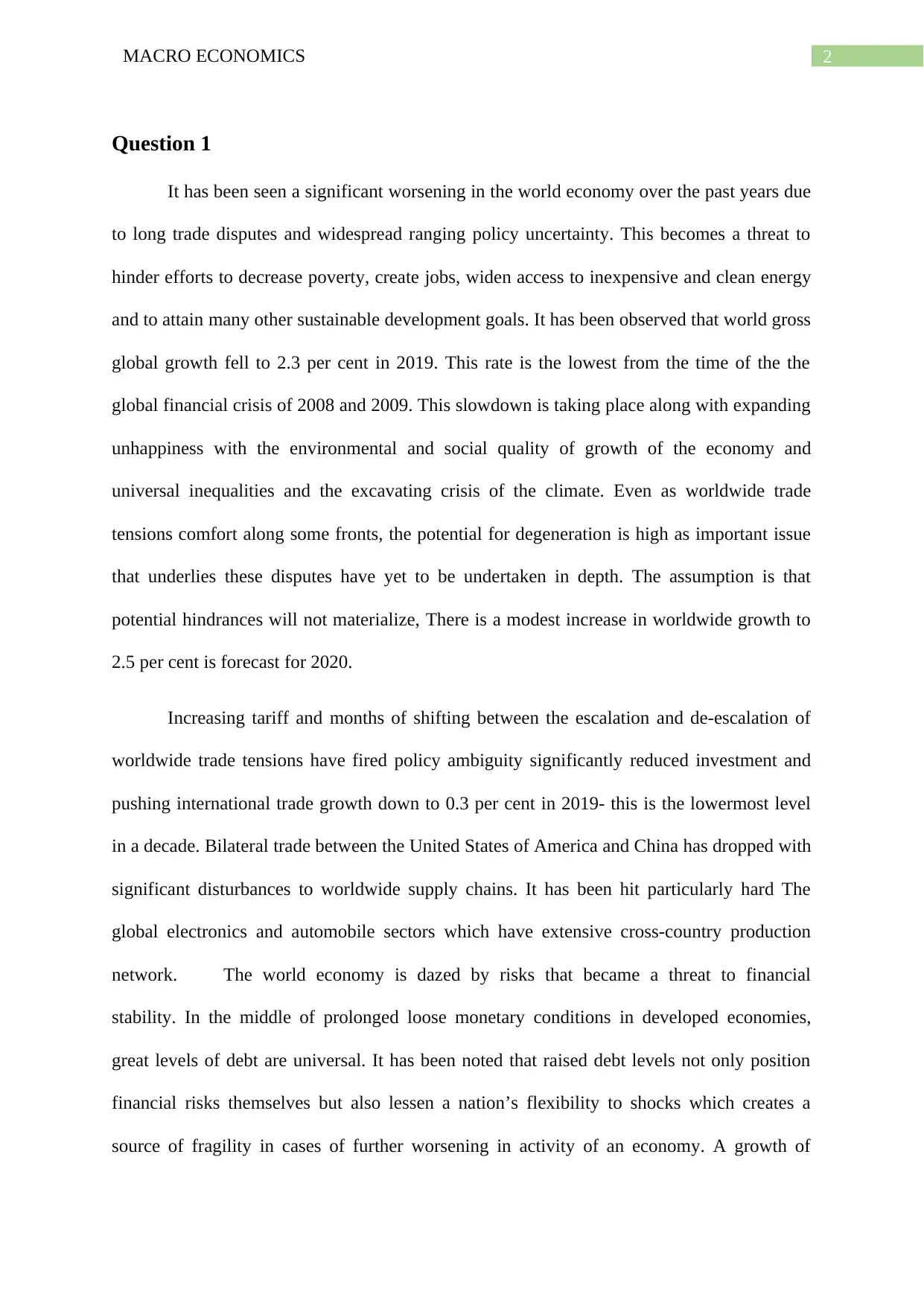
2MACRO ECONOMICS
Question 1
It has been seen a significant worsening in the world economy over the past years due
to long trade disputes and widespread ranging policy uncertainty. This becomes a threat to
hinder efforts to decrease poverty, create jobs, widen access to inexpensive and clean energy
and to attain many other sustainable development goals. It has been observed that world gross
global growth fell to 2.3 per cent in 2019. This rate is the lowest from the time of the the
global financial crisis of 2008 and 2009. This slowdown is taking place along with expanding
unhappiness with the environmental and social quality of growth of the economy and
universal inequalities and the excavating crisis of the climate. Even as worldwide trade
tensions comfort along some fronts, the potential for degeneration is high as important issue
that underlies these disputes have yet to be undertaken in depth. The assumption is that
potential hindrances will not materialize, There is a modest increase in worldwide growth to
2.5 per cent is forecast for 2020.
Increasing tariff and months of shifting between the escalation and de-escalation of
worldwide trade tensions have fired policy ambiguity significantly reduced investment and
pushing international trade growth down to 0.3 per cent in 2019- this is the lowermost level
in a decade. Bilateral trade between the United States of America and China has dropped with
significant disturbances to worldwide supply chains. It has been hit particularly hard The
global electronics and automobile sectors which have extensive cross-country production
network. The world economy is dazed by risks that became a threat to financial
stability. In the middle of prolonged loose monetary conditions in developed economies,
great levels of debt are universal. It has been noted that raised debt levels not only position
financial risks themselves but also lessen a nation’s flexibility to shocks which creates a
source of fragility in cases of further worsening in activity of an economy. A growth of
Question 1
It has been seen a significant worsening in the world economy over the past years due
to long trade disputes and widespread ranging policy uncertainty. This becomes a threat to
hinder efforts to decrease poverty, create jobs, widen access to inexpensive and clean energy
and to attain many other sustainable development goals. It has been observed that world gross
global growth fell to 2.3 per cent in 2019. This rate is the lowest from the time of the the
global financial crisis of 2008 and 2009. This slowdown is taking place along with expanding
unhappiness with the environmental and social quality of growth of the economy and
universal inequalities and the excavating crisis of the climate. Even as worldwide trade
tensions comfort along some fronts, the potential for degeneration is high as important issue
that underlies these disputes have yet to be undertaken in depth. The assumption is that
potential hindrances will not materialize, There is a modest increase in worldwide growth to
2.5 per cent is forecast for 2020.
Increasing tariff and months of shifting between the escalation and de-escalation of
worldwide trade tensions have fired policy ambiguity significantly reduced investment and
pushing international trade growth down to 0.3 per cent in 2019- this is the lowermost level
in a decade. Bilateral trade between the United States of America and China has dropped with
significant disturbances to worldwide supply chains. It has been hit particularly hard The
global electronics and automobile sectors which have extensive cross-country production
network. The world economy is dazed by risks that became a threat to financial
stability. In the middle of prolonged loose monetary conditions in developed economies,
great levels of debt are universal. It has been noted that raised debt levels not only position
financial risks themselves but also lessen a nation’s flexibility to shocks which creates a
source of fragility in cases of further worsening in activity of an economy. A growth of
⊘ This is a preview!⊘
Do you want full access?
Subscribe today to unlock all pages.

Trusted by 1+ million students worldwide
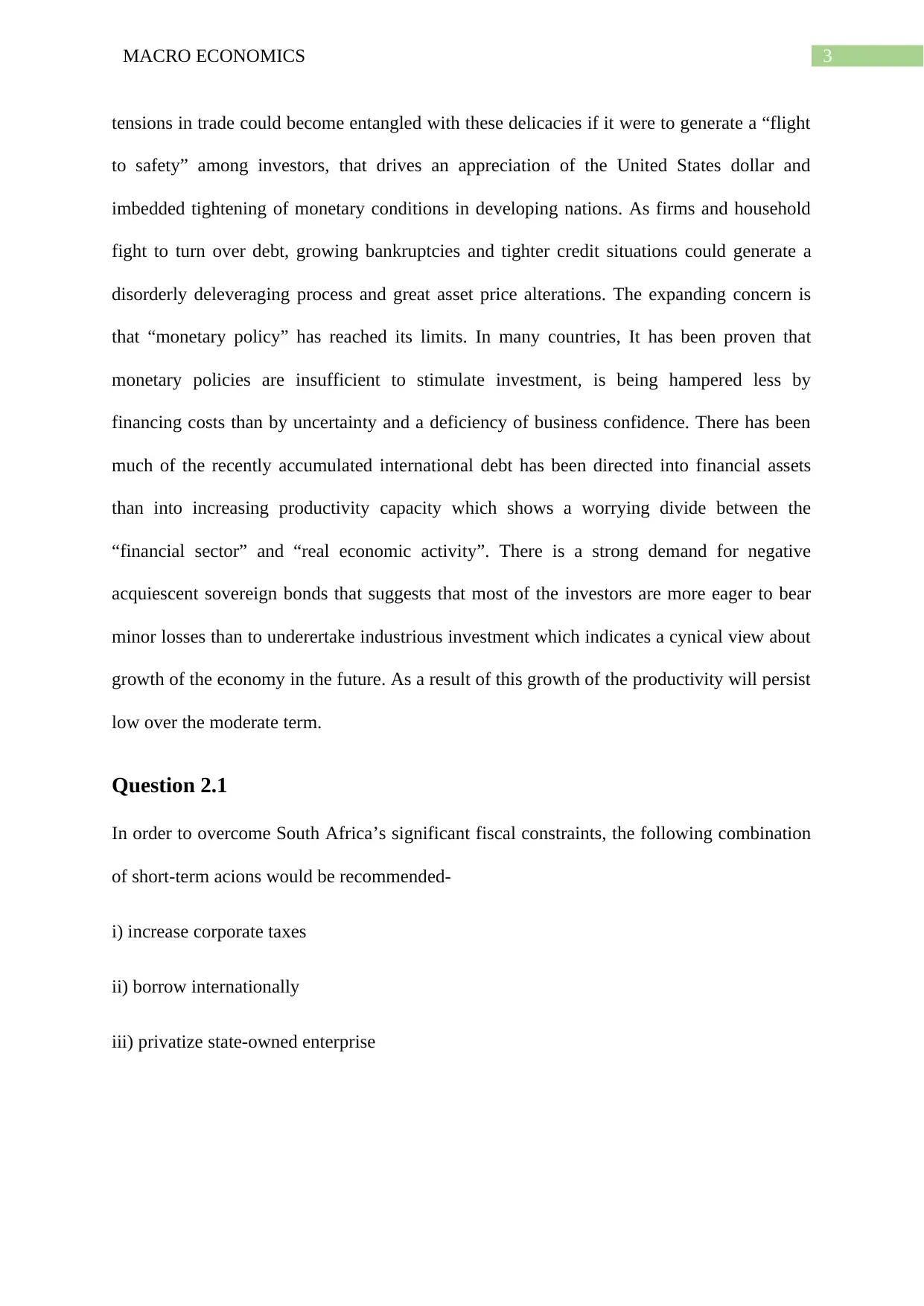
3MACRO ECONOMICS
tensions in trade could become entangled with these delicacies if it were to generate a “flight
to safety” among investors, that drives an appreciation of the United States dollar and
imbedded tightening of monetary conditions in developing nations. As firms and household
fight to turn over debt, growing bankruptcies and tighter credit situations could generate a
disorderly deleveraging process and great asset price alterations. The expanding concern is
that “monetary policy” has reached its limits. In many countries, It has been proven that
monetary policies are insufficient to stimulate investment, is being hampered less by
financing costs than by uncertainty and a deficiency of business confidence. There has been
much of the recently accumulated international debt has been directed into financial assets
than into increasing productivity capacity which shows a worrying divide between the
“financial sector” and “real economic activity”. There is a strong demand for negative
acquiescent sovereign bonds that suggests that most of the investors are more eager to bear
minor losses than to underertake industrious investment which indicates a cynical view about
growth of the economy in the future. As a result of this growth of the productivity will persist
low over the moderate term.
Question 2.1
In order to overcome South Africa’s significant fiscal constraints, the following combination
of short-term acions would be recommended-
i) increase corporate taxes
ii) borrow internationally
iii) privatize state-owned enterprise
tensions in trade could become entangled with these delicacies if it were to generate a “flight
to safety” among investors, that drives an appreciation of the United States dollar and
imbedded tightening of monetary conditions in developing nations. As firms and household
fight to turn over debt, growing bankruptcies and tighter credit situations could generate a
disorderly deleveraging process and great asset price alterations. The expanding concern is
that “monetary policy” has reached its limits. In many countries, It has been proven that
monetary policies are insufficient to stimulate investment, is being hampered less by
financing costs than by uncertainty and a deficiency of business confidence. There has been
much of the recently accumulated international debt has been directed into financial assets
than into increasing productivity capacity which shows a worrying divide between the
“financial sector” and “real economic activity”. There is a strong demand for negative
acquiescent sovereign bonds that suggests that most of the investors are more eager to bear
minor losses than to underertake industrious investment which indicates a cynical view about
growth of the economy in the future. As a result of this growth of the productivity will persist
low over the moderate term.
Question 2.1
In order to overcome South Africa’s significant fiscal constraints, the following combination
of short-term acions would be recommended-
i) increase corporate taxes
ii) borrow internationally
iii) privatize state-owned enterprise
Paraphrase This Document
Need a fresh take? Get an instant paraphrase of this document with our AI Paraphraser
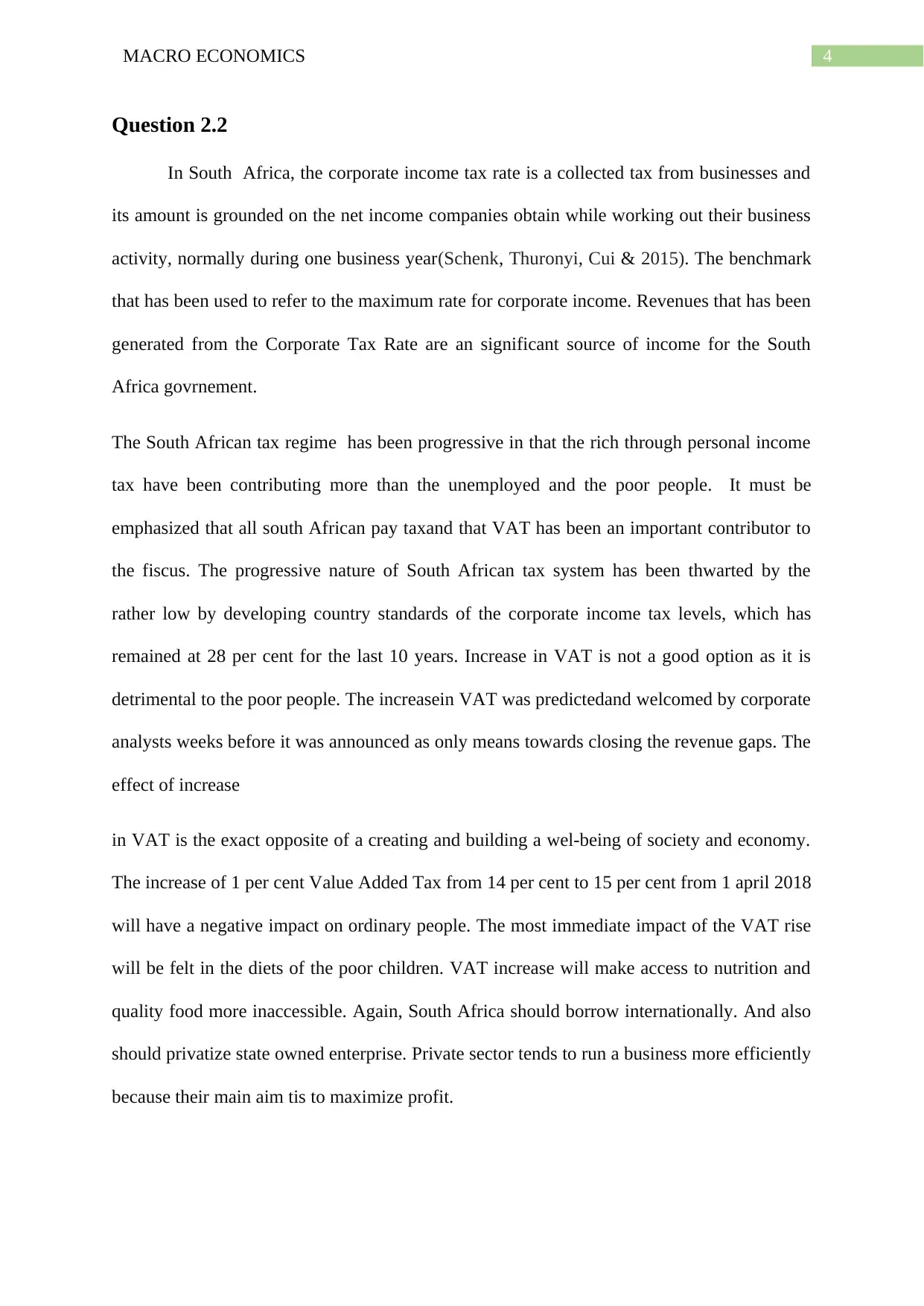
4MACRO ECONOMICS
Question 2.2
In South Africa, the corporate income tax rate is a collected tax from businesses and
its amount is grounded on the net income companies obtain while working out their business
activity, normally during one business year(Schenk, Thuronyi, Cui & 2015). The benchmark
that has been used to refer to the maximum rate for corporate income. Revenues that has been
generated from the Corporate Tax Rate are an significant source of income for the South
Africa govrnement.
The South African tax regime has been progressive in that the rich through personal income
tax have been contributing more than the unemployed and the poor people. It must be
emphasized that all south African pay taxand that VAT has been an important contributor to
the fiscus. The progressive nature of South African tax system has been thwarted by the
rather low by developing country standards of the corporate income tax levels, which has
remained at 28 per cent for the last 10 years. Increase in VAT is not a good option as it is
detrimental to the poor people. The increasein VAT was predictedand welcomed by corporate
analysts weeks before it was announced as only means towards closing the revenue gaps. The
effect of increase
in VAT is the exact opposite of a creating and building a wel-being of society and economy.
The increase of 1 per cent Value Added Tax from 14 per cent to 15 per cent from 1 april 2018
will have a negative impact on ordinary people. The most immediate impact of the VAT rise
will be felt in the diets of the poor children. VAT increase will make access to nutrition and
quality food more inaccessible. Again, South Africa should borrow internationally. And also
should privatize state owned enterprise. Private sector tends to run a business more efficiently
because their main aim tis to maximize profit.
Question 2.2
In South Africa, the corporate income tax rate is a collected tax from businesses and
its amount is grounded on the net income companies obtain while working out their business
activity, normally during one business year(Schenk, Thuronyi, Cui & 2015). The benchmark
that has been used to refer to the maximum rate for corporate income. Revenues that has been
generated from the Corporate Tax Rate are an significant source of income for the South
Africa govrnement.
The South African tax regime has been progressive in that the rich through personal income
tax have been contributing more than the unemployed and the poor people. It must be
emphasized that all south African pay taxand that VAT has been an important contributor to
the fiscus. The progressive nature of South African tax system has been thwarted by the
rather low by developing country standards of the corporate income tax levels, which has
remained at 28 per cent for the last 10 years. Increase in VAT is not a good option as it is
detrimental to the poor people. The increasein VAT was predictedand welcomed by corporate
analysts weeks before it was announced as only means towards closing the revenue gaps. The
effect of increase
in VAT is the exact opposite of a creating and building a wel-being of society and economy.
The increase of 1 per cent Value Added Tax from 14 per cent to 15 per cent from 1 april 2018
will have a negative impact on ordinary people. The most immediate impact of the VAT rise
will be felt in the diets of the poor children. VAT increase will make access to nutrition and
quality food more inaccessible. Again, South Africa should borrow internationally. And also
should privatize state owned enterprise. Private sector tends to run a business more efficiently
because their main aim tis to maximize profit.
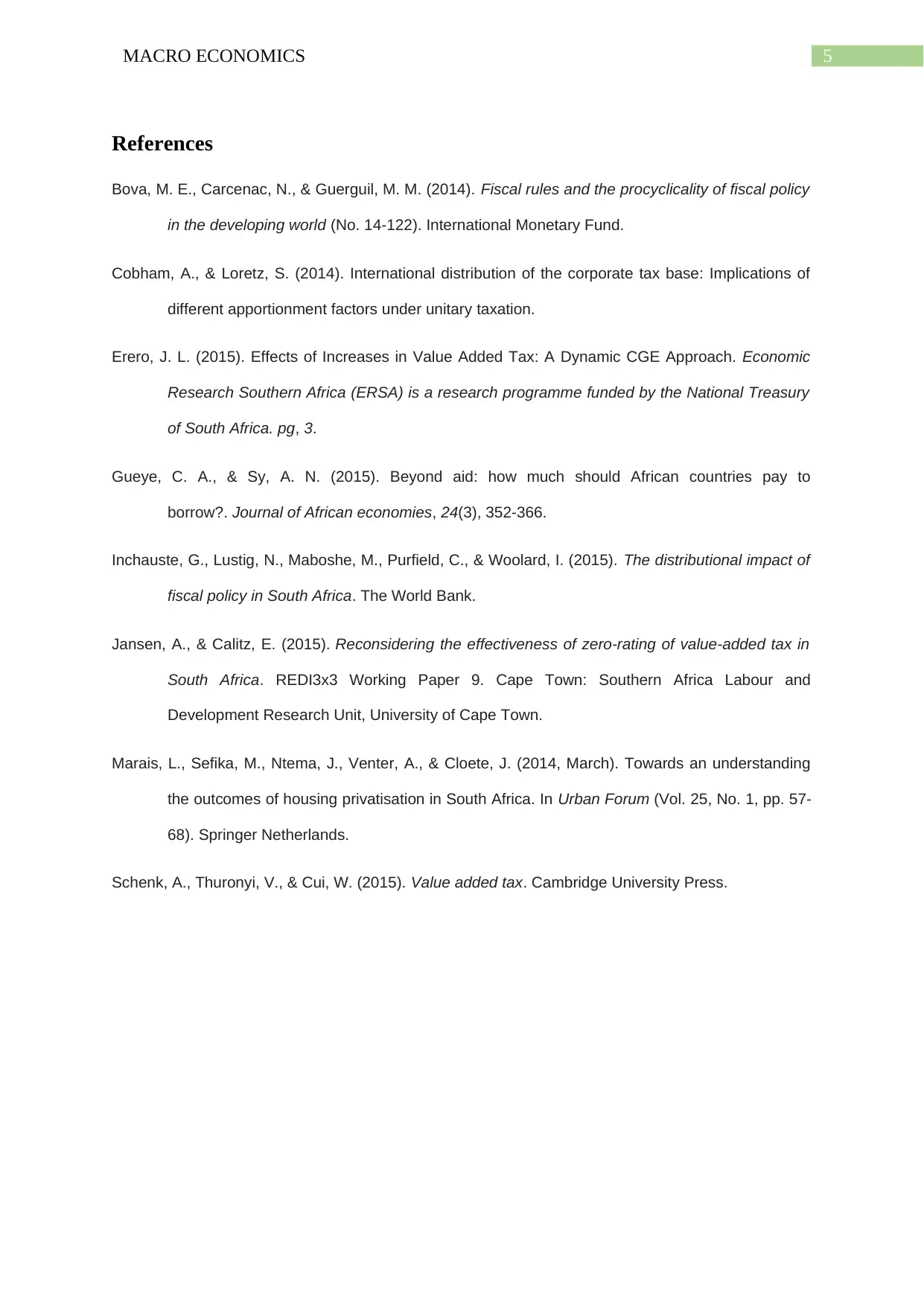
5MACRO ECONOMICS
References
Bova, M. E., Carcenac, N., & Guerguil, M. M. (2014). Fiscal rules and the procyclicality of fiscal policy
in the developing world (No. 14-122). International Monetary Fund.
Cobham, A., & Loretz, S. (2014). International distribution of the corporate tax base: Implications of
different apportionment factors under unitary taxation.
Erero, J. L. (2015). Effects of Increases in Value Added Tax: A Dynamic CGE Approach. Economic
Research Southern Africa (ERSA) is a research programme funded by the National Treasury
of South Africa. pg, 3.
Gueye, C. A., & Sy, A. N. (2015). Beyond aid: how much should African countries pay to
borrow?. Journal of African economies, 24(3), 352-366.
Inchauste, G., Lustig, N., Maboshe, M., Purfield, C., & Woolard, I. (2015). The distributional impact of
fiscal policy in South Africa. The World Bank.
Jansen, A., & Calitz, E. (2015). Reconsidering the effectiveness of zero-rating of value-added tax in
South Africa. REDI3x3 Working Paper 9. Cape Town: Southern Africa Labour and
Development Research Unit, University of Cape Town.
Marais, L., Sefika, M., Ntema, J., Venter, A., & Cloete, J. (2014, March). Towards an understanding
the outcomes of housing privatisation in South Africa. In Urban Forum (Vol. 25, No. 1, pp. 57-
68). Springer Netherlands.
Schenk, A., Thuronyi, V., & Cui, W. (2015). Value added tax. Cambridge University Press.
References
Bova, M. E., Carcenac, N., & Guerguil, M. M. (2014). Fiscal rules and the procyclicality of fiscal policy
in the developing world (No. 14-122). International Monetary Fund.
Cobham, A., & Loretz, S. (2014). International distribution of the corporate tax base: Implications of
different apportionment factors under unitary taxation.
Erero, J. L. (2015). Effects of Increases in Value Added Tax: A Dynamic CGE Approach. Economic
Research Southern Africa (ERSA) is a research programme funded by the National Treasury
of South Africa. pg, 3.
Gueye, C. A., & Sy, A. N. (2015). Beyond aid: how much should African countries pay to
borrow?. Journal of African economies, 24(3), 352-366.
Inchauste, G., Lustig, N., Maboshe, M., Purfield, C., & Woolard, I. (2015). The distributional impact of
fiscal policy in South Africa. The World Bank.
Jansen, A., & Calitz, E. (2015). Reconsidering the effectiveness of zero-rating of value-added tax in
South Africa. REDI3x3 Working Paper 9. Cape Town: Southern Africa Labour and
Development Research Unit, University of Cape Town.
Marais, L., Sefika, M., Ntema, J., Venter, A., & Cloete, J. (2014, March). Towards an understanding
the outcomes of housing privatisation in South Africa. In Urban Forum (Vol. 25, No. 1, pp. 57-
68). Springer Netherlands.
Schenk, A., Thuronyi, V., & Cui, W. (2015). Value added tax. Cambridge University Press.
⊘ This is a preview!⊘
Do you want full access?
Subscribe today to unlock all pages.

Trusted by 1+ million students worldwide
1 out of 6
Related Documents
Your All-in-One AI-Powered Toolkit for Academic Success.
+13062052269
info@desklib.com
Available 24*7 on WhatsApp / Email
![[object Object]](/_next/static/media/star-bottom.7253800d.svg)
Unlock your academic potential
Copyright © 2020–2025 A2Z Services. All Rights Reserved. Developed and managed by ZUCOL.





